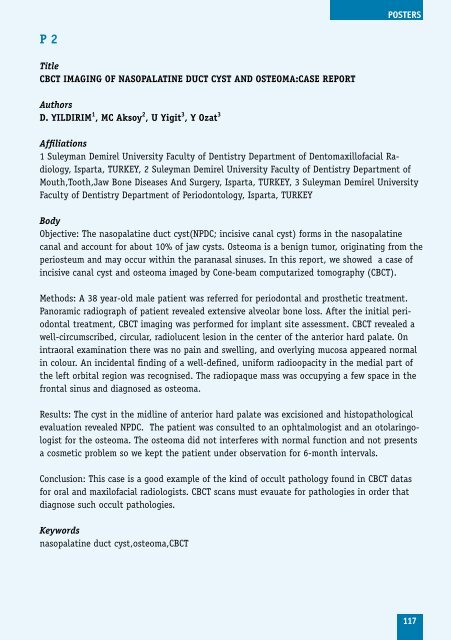Program including abstracts as pdf available here
Program including abstracts as pdf available here
Program including abstracts as pdf available here
Create successful ePaper yourself
Turn your PDF publications into a flip-book with our unique Google optimized e-Paper software.
P 2<br />
Title<br />
CbCT IMAGING OF NASOPALATINE DuCT CyST AND OSTEOMA:CASE REPORT<br />
Authors<br />
D. yILDIRIM 1 , MC Aksoy 2 , u yigit 3 , y Ozat 3<br />
Affiliations<br />
1 Suleyman Demirel University Faculty of Dentistry Department of Dentomaxillofacial Radiology,<br />
Isparta, TURKEY, 2 Suleyman Demirel University Faculty of Dentistry Department of<br />
Mouth,Tooth,Jaw Bone Dise<strong>as</strong>es And Surgery, Isparta, TURKEY, 3 Suleyman Demirel University<br />
Faculty of Dentistry Department of Periodontology, Isparta, TURKEY<br />
Body<br />
Objective: The n<strong>as</strong>opalatine duct cyst(NPDC; incisive canal cyst) forms in the n<strong>as</strong>opalatine<br />
canal and account for about 10% of jaw cysts. Osteoma is a benign tumor, originating from the<br />
periosteum and may occur within the paran<strong>as</strong>al sinuses. In this report, we showed a c<strong>as</strong>e of<br />
incisive canal cyst and osteoma imaged by Cone-beam computarized tomography (CBCT).<br />
Methods: A 38 year-old male patient w<strong>as</strong> referred for periodontal and prosthetic treatment.<br />
Panoramic radiograph of patient revealed extensive alveolar bone loss. After the initial periodontal<br />
treatment, CBCT imaging w<strong>as</strong> performed for implant site <strong>as</strong>sessment. CBCT revealed a<br />
well-circumscribed, circular, radiolucent lesion in the center of the anterior hard palate. On<br />
intraoral examination t<strong>here</strong> w<strong>as</strong> no pain and swelling, and overlying mucosa appeared normal<br />
in colour. An incidental finding of a well-defined, uniform radioopacity in the medial part of<br />
the left orbital region w<strong>as</strong> recognised. The radiopaque m<strong>as</strong>s w<strong>as</strong> occupying a few space in the<br />
frontal sinus and diagnosed <strong>as</strong> osteoma.<br />
Results: The cyst in the midline of anterior hard palate w<strong>as</strong> excisioned and histopathological<br />
evaluation revealed NPDC. The patient w<strong>as</strong> consulted to an ophtalmologist and an otolaringologist<br />
for the osteoma. The osteoma did not interferes with normal function and not presents<br />
a cosmetic problem so we kept the patient under observation for 6-month intervals.<br />
Conclusion: This c<strong>as</strong>e is a good example of the kind of occult pathology found in CBCT dat<strong>as</strong><br />
for oral and maxilofacial radiologists. CBCT scans must evauate for pathologies in order that<br />
diagnose such occult pathologies.<br />
Keywords<br />
n<strong>as</strong>opalatine duct cyst,osteoma,CBCT<br />
POSTerS<br />
117


